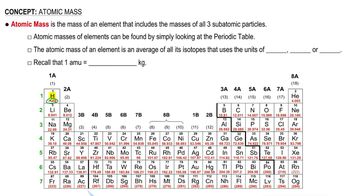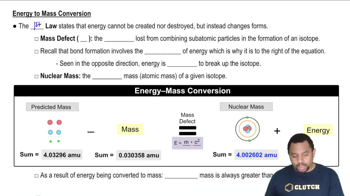An aqueous KNO3 solution is made using 72.5 g of KNO3 diluted to a total solution volume of 2.00 L. Calculate the mass percent of the solution. (Assume a density of 1.05 g/mL for the solution.)
Ch.14 - Solutions

Chapter 14, Problem 56
A dioxin-contaminated water source contains 0.085% dioxin by mass. How much dioxin is present in 2.5 L of this water? Assume a density of 1.00 g/mL.
 Verified step by step guidance
Verified step by step guidance1
Convert the volume of water from liters to milliliters using the conversion factor: 1 L = 1000 mL.
Calculate the mass of the water using the density formula: \( \text{mass} = \text{density} \times \text{volume} \).
Determine the mass of dioxin in the water by using the percentage by mass: \( \text{mass of dioxin} = \text{mass of water} \times \frac{0.085}{100} \).
Ensure all units are consistent and check calculations for accuracy.
Summarize the steps and ensure understanding of the concept of percentage by mass and its application in this context.

Verified video answer for a similar problem:
This video solution was recommended by our tutors as helpful for the problem above.
Video duration:
2mWas this helpful?
Key Concepts
Here are the essential concepts you must grasp in order to answer the question correctly.
Concentration by Mass
Concentration by mass refers to the amount of solute (in this case, dioxin) present in a given mass of solution. It is often expressed as a percentage, indicating how many grams of solute are present in 100 grams of solution. Understanding this concept is crucial for calculating the mass of dioxin in a specific volume of contaminated water.
Recommended video:
Guided course

Atomic Mass
Density
Density is defined as mass per unit volume and is a key property of substances. In this scenario, the density of the water is given as 1.00 g/mL, which means that 1 mL of water has a mass of 1 gram. This information allows us to convert the volume of water (2.5 L) into mass, which is necessary for calculating the total mass of dioxin present.
Recommended video:
Guided course

Density Concepts
Volume to Mass Conversion
To find the mass of a substance from its volume, we use the formula: mass = volume × density. In this case, converting 2.5 L of water to grams using the provided density allows us to determine the total mass of the water, which is essential for applying the concentration percentage to find the mass of dioxin present in the water.
Recommended video:
Guided course

Energy to Mass Conversion
Related Practice
Textbook Question
Textbook Question
To what volume should you dilute 50.0 mL of a 5.00 M KI solution so that 25.0 mL of the diluted solution contains 3.05 g of KI?
4
views
Textbook Question
Silver nitrate solutions are often used to plate silver onto other metals. What is the maximum amount of silver (in grams) that can be plated out of 4.8 L of an AgNO3 solution containing 3.4% Ag by mass? Assume that the density of the solution is 1.01 g/mL.
Textbook Question
Lead is a toxic metal that affects the central nervous system. A Pb-contaminated water sample contains 0.0011% Pb by mass. How much of the water (in mL) contains 150 mg of Pb? (Assume a density of 1.0 g/mL.)
